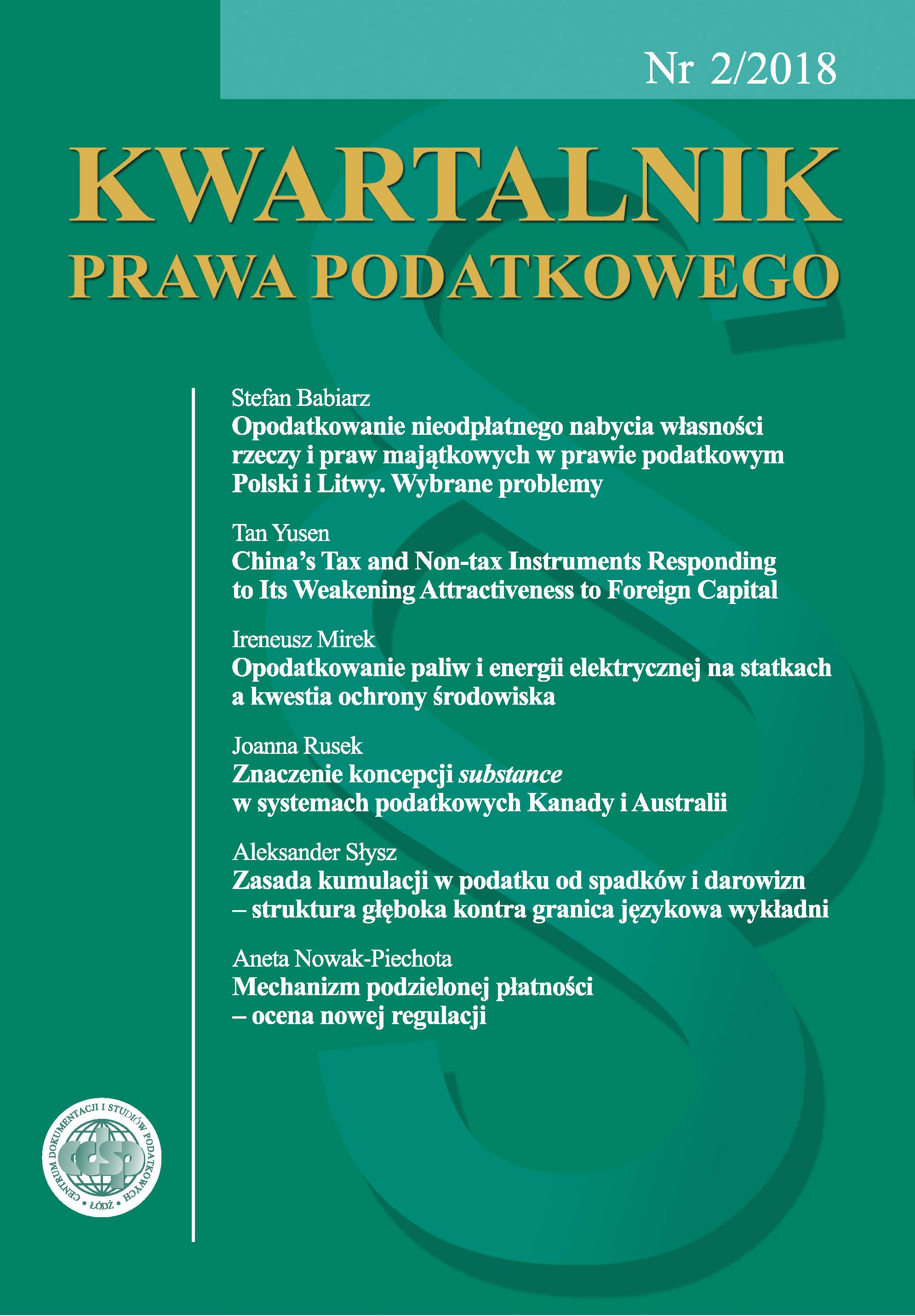China’s tax and non-tax instruments responding to its weakening attractiveness to foreign capital
DOI:
https://doi.org/10.18778/1509-877X.2018.02.02Keywords:
attractiveness to foreign capital, non-tax measures, comparative advantageAbstract
This paper studies China’s weakening in its attractiveness to foreign capital, especially since its implementation of new corporate income tax law in year 2008, which phased out the former preferential tax treatments for foreign invested enterprises and the placed-based favourable tax policies for various special tax zones. Empirical evidence and the major factors causing this weakening in attracting foreign investment are discussed. This paper also studies the major tax measures, fiscal measures and non-tax measures adopted by China central and regional governments, which are aimed to improve China’s competitiveness in attracting foreign capital. The major contribution of this paper is its discussion on China’s good practice of making use of nonta Xmeasures to attract foreign capital, which is effective in avoiding harmful international ta Xcompetition. The other contribution of this paper is the discussion on the economic foundation (i.e. China’s comparative strength and state ownership of lands) which makes these non-tax measures feasible. China’s good practice of adopting non-tax measures and making use of its comparative strength is of reference value to other capital importing countries in the world.
Downloads
References
Ahrens J., Meyer-Baudeck A., Special Economic Zones: Shortcut or Roundabout Way towards Capitalism, “Intereconomics”, March / April 1995.
Google Scholar
Azuma Y., Kurihara J., Examining China’s Local Government Fiscal Dynamics: With a Special Emphasis on Local Investment Companies (LICs), “Cambridge Gazette: Politico-Economic Commentaries”, 3 January 2011, no. 5.
Google Scholar
Bräutigam D., Tang X., “Going Global in Groups”: Structural Transformation and China’s Special Economic Zones Overseas, “World Development” 2014, vol. 63.
Google Scholar
Huang J., He C., Wei Y.H.D., A Comparative Study of Efficiency of Electronics Firms Located within and outside Development Zones in Shanghai, “Habitat International” 2016, vol. 56.
Google Scholar
Jarosiński K., Maśloch G., The Impact of Special Economic Zones on the Level of Socio- Economic Changes of Polish Regions, Warsaw Forum of Economic Sociology, Autumn 2016, vol. 7, no. 2 (14).
Google Scholar
Journalist Du T., The Differential in Financing Costs Among Enterprises Is Big, and the Difficulty and High Cost in Financing for Medium and Small Size Enterprises are more and more Notable, Published on “Economic Observer”, https://finance.sina.cn (accessed: 7.05.2018).
Google Scholar
Laukkanen A., The Development Aspects of Special Tax Zones, “Bulletin for International Taxation” 2016, vol. 70, no. 3.
Google Scholar
Lipták F., Klasová S., Kováč V., Special Economic Zone Constitution According to Cluster Analysis, “Procedia Economics and Finance” 2015, no. 27.
Google Scholar
The Notice on Relevant Policies of Deepening VAT Reform (财政部 税务总局 海关总 署公告2019年第39号/ Notice No. 39 [2019] issued by Ministry of Finance, General Administration of Taxation, General Administration of Customs).
Google Scholar
Parwez S., Sen V., Special Economic Zone, Land Acquisition, and Impact on Rural India, “Emerging Economy Studies” 2016, vol. 2 (2).
Google Scholar
Smętkowski M., Polish Special Economic Zones as an Instrument of Regional and Industrial Policy, “Munich Personal RePEc Archive”, http://mpra.ub.uni-muenchen.de/39184/ (accessed: 15.04.2018), MPRA Paper No. 39184, posted on 19 June 2012.
Google Scholar
Sosnovskikh S., Industrial Cluster in Russia: The Development of Special Economic Zones and Industrial Parks, “Russian Journal of Economics” 2017, vol. 3.
Google Scholar
Wang J., The Economic Impact of Special Economic Zones: Evidence from Chinese Municipalities, “Journal of Development Economics” 2013, vol. 101.
Google Scholar
Wu X., Foreign Capital Is Flowing Out of China and Why?, “Finance and Economy First We Media – Wu Xiaobo Channel”, 6 May 2018.
Google Scholar
Zhang J., Interjurisdictional Competition for FDI: The Case of China’s “Development Zone Fever”, “Regional Science and Urban Economics” 2011, vol. 41.
Google Scholar
Zheng G., Barbieri E., Tommaso M., Zhang L., Development Zones and Local Economic Growth: Zooming in on the Chinese Case, “China Economic Review” 2016, vol. 38.
Google Scholar
何书金/He S., 苏光全/Su G.,开发区闲置土地成因机制及类型划分/ The Formation Mechanism and Classification of the Types of Idle Lands within Development Zones, “资源科学/Resources Science” 2001, vol. 05.
Google Scholar
龙开胜/Long K., 秦洁/Qin J., 陈利根/Chen L., 开发区闲置土地成因及其治理路 径——以北方A市高新技术产业开发区为例/ The Cause of the Idle Lands within Development Zones and its Governance Path – Taking a High Technology Industry Development Zone Located in City A in Northern China as Example, “中国人口·资源 与环境/China Population, Resources and Environment” 2014, vol. 24 (1).
Google Scholar
卢新海/Lu X.,开发区土地资源的利用与管理/The Use and Administration of Land Resources within Development Zones, “中国土地科学/China Land Science” 2004, vol. 02.
Google Scholar
张克俊/Zhang K., 李瑛/Li Y., 开发区失地农民就业问题研究/Study to the Employment Issue Linked with the Peasants Losing Their Lands for the Construction of Development Zones, “农村经济/Rural Economy” 2008, vol. 03.
Google Scholar
Downloads
Published
How to Cite
Issue
Section
License

This work is licensed under a Creative Commons Attribution-NonCommercial-NoDerivatives 4.0 International License.
PlumX metrics









